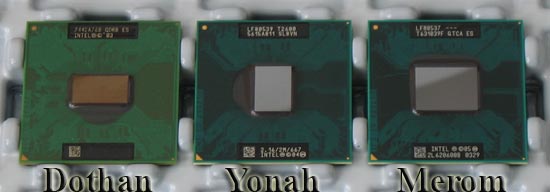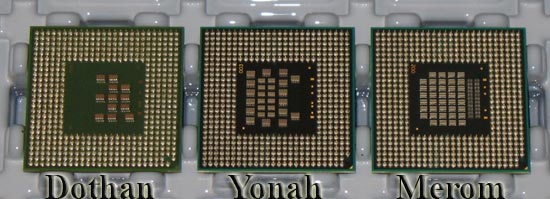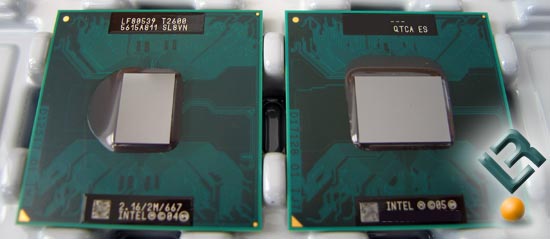Intel Core 2 Duo Processor T7600 on the Dell XPS M1710
Intel T7600 ‘Merom’ Up Close and Naked
Over the past couple years the Intel family of mobile processors has undergone a lot of changes. The last single core mobile processor was the Pentium M series with the Dothan core. The Dothan core was launched on May 10, 2004. Dothan Pentium M processors are among the first Intel processors to be identified using a “processor number” rather than a clockspeed rating, and they made up the 7xx series. Dothan processors retained the same basic design as the original Pentium M, but were manufactured using a 90nm process, with twice the secondary cache. The die size on a Dothan is 84mm2 containing ~140 million transistors, most of which make up the 2MB cache. Intel rated the TDP on Dothan as 21 Watts (down from 24.5W in Banias).

Dothan lead the mobile industry for performance and power consumption for nearly two years and on January 5, 2006 Intel launched the first dual-core processor known as Yonah. Yonah was still based on the Banias/Dothan Pentium M microarchitecture that we have all grown accustomed to, but also included new features like SSE3 instructions, NX bit, LaGrande security technology, and a number of other small improvements. Yonah featured 667MHx front side bus (FSB), which was an improvement from the 533MHz FSB used by the previous Pentium M series. The cache remained at 2MB and was shared between both cores. As mentioned previously the Dothan die was a mere 84mm2 and Yonah only slightly increased the die size to 90mm2, which was good news for Intel as the TDP ‘only’ went up from 21W in the single core Dothan to 31W in the dual-core Yonah series. With the Launch of Yonah brought the need for a new chipset that supports Core Duo processors and for that reason Intel also changed the pins layout as seen below.

With Yonah not even launched for a full eight months Intel is already releasing their next mobile processor and this time around it’s going to be known as a Core 2 Duo processor based off the Merom core. Intel originally announced Merom on July 27, 2006, but is just now allowing performance numbers to be officially released. It seems as if Intel had the first mobile version of the Core 2 ready for some time , but just wanted to give the OEM’s and ODM’s enough time to get BIOS updates ready for the processor. The good news is that Merom is drop-in compatible with the current Core Duo platform, requiring at most a BIOS update (a few odd ball notebooks won’t work, but we haven’t seen one fail yet). Intel has claimed that Merom will provide 20% more performance yet maintain the same battery life as the Yonah-based Core Duo. Other than doubling the cache from 2MB to 4MB, Merom will be the first Intel mobile processor to finally feature EM64T 64-bit extensions. The TDP on Merom is 32W, which means it does consume 1W more than the Dothan rated at 31W.

Here are the two processors that were used in the review. The Core Duo T2600 is one on the left and is one that Legit Reviews purchased on our own, so it is an retail boxed T2600 rated at 2.13GHz. The bad boy on the right it the brand new Intel Core 2 Duo processor T7600 and is rated at 2.33GHz. Notice the larger die size as the cache has doubled from 2MB to 4MB greatly increasing the die size, which means fewer processors per wafer! The die size on the Core 2 Duo is approximately 143mm2 and contains roughly 291 million transistors.

Comments are closed.